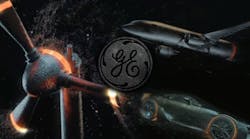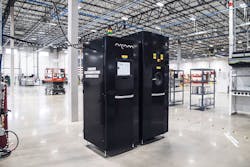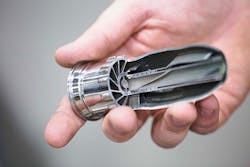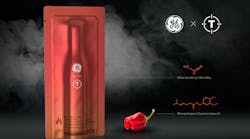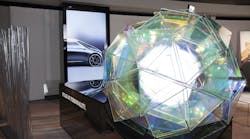Since its first major foray into 3D printing with the LEAP engine fuel nozzle, GE has consistently tested and redefined the upper limits of additive manufacturing . When most companies were experimenting with ABS plastics to create colorful approximations of their final product, GE was laying down metal powder and blasting it with lasers to forge a highly complex fuel nozzle with a geometric complexity and durability impossible to reach by conventional machining.
Since acquiring Morris Technologies, the company behind the Direct Metal Laser Melting (DLML) process used for the nozzle, in 2012, GE has gradually added onto its manufacturing empire, creating GE Additive. Last year, GE acquired 74% of Arcam AB, a Swedish maker of Electron Beam Melting (EBM) machines, as well as 75% of the Germany-based Concept Laser, to leverage its DMLM technology.
By 2020, GE expects to invest $3.5 billion in additive manufacturing. The entire industry was worth $6 billion in 2016, according to Wohlers Associates.
This quick video gives you an idea of GE's ambition, which is to essentially to 3D print everything.
But what does it all mean right now? We recently talked to Kirk Rogers, the technology leader for GE's new Center for Additive Technology Advancement (CATA) near Pittsburgh, about the basics of both technologies and how GE's AM strategy could not only disrupt manufacturing, but redefine it.
NED: So Kirk, what do you do for GE Additive?
Kirk Rogers: I work on work on university partnerships and regional initiatives that we have for the Pittsburgh and Northeast Ohio region. Then my day job is really trying to find the right technologies to mate with GE projects. That's kind of been my last 18 months. And the CATA center is GE internally focused resource to try and get additive manufacturing into the supply chain.
Now that GE Additive is a half-year old and CATA is turning into a Customer Experience Center, that role is morphing a little bit into one of the customer technical interfaces to help our customers solve problems and mate the right technology to the problems they have.
NED: You're going to be speaking at the Canadian Manufacturing Technology Show on Sep. 26 about the future of additive manufacturing. Can you give us a preview?
KR: When I talk to the average person on the street they don't know what 3D printing is. Their kids probably do but they don't. So I'll be setting the stage and talking in general and trying to inspire people with the really cool things that GE and others have done that not everybody might be aware of.
NED: Can you tell us about a few types of additive technologies and when they'd be used?
KR: Everybody wants their prototype part yesterday. With smaller FDM machines, like from Stratasys, we'll make tools for a casting and get it in the same week that we make the tools whereas, typically it might be 12 or 13 weeks to have somebody make a pattern to make that first casting. So instead, we'll design and print the tools and take them to the casting house. Some casting houses are starting to build or buy their own 3D printers and hiring high school kids to run them.
NED: High school kids? Really?
KR: One foundry in Massachusetts hired two part time kids and they do all of the programming for their pattern making tools. People that traditionally do those jobs in the pattern shop and the foundries are all 50 plus and either retiring or something worse, like getting injured on the job. The skills are going away faster than they're being replaced at this point.
Running a machines is definitely is more intuitive for people who grew up with the technology. You drive a computer to program the thing. You don't actually make something by hand on a lathe and a band saw typically used in the foundries. That's just one kind of very common use case that provides a lot of value in industry today. And it's still just growing, because it's not widely adopted.
NED: What can you tell us about the ATLAS?
KR: ATLAS has a powder bed modality and will be able to print in a "build envelop" of one meter cubed. We'll be exhibiting the meter-class machine at Formnext in November in Germany.
NED: Where can you get bigger parts now?
KR: One option is Additive Engineering Solutions in Akron, the first company to do a BAAM (Big Area Additive Manufacturing) style service bureau. You can order huge tools and fixtures and jigs feet by feet and get them quickly. The value there is in composite tooling for large things like wind blades, which is one of the reason why GE is interested.
NED: GE Additive offers both laser and electron-based technologies. What can you tell us about these, and how they're reshaping manufacturing?
KR: In both laser-powered, which is more popular, and electron-powered, you're spreading a thin layer of metal powder and then using the energy source whether it's laser or electron beam, to basically weld that powder together to make your shape.
Lots of people are attracted to the laser based process because you can get very good tolerances very good feature resolution and make shapes that are completely impossible to make by other manufacturing techniques.
Think about injection molding tool inserts or thermal forming inserts that have conformal cooling. That's been kind of a holy grail to go faster in injection molding and get the heat out of the part once you've injected the plastic in. Inserts allow cooling channels right near the surface of the part, and being able to contour those arbitrarily versus drilling holes from the outside. With the traditional way, you can only drill straight holes; you can't drill a serpentine hole. Printing layer by printing, you can create those channels, and they are really where the designer wants it, not where the limits of the manufacturing technology can place it.
In GE's famous fuel nozzle example the inside is designed better for the fuel and air flow so that you get better combustion which means lower emissions and better fuel economy. And by combining 20 parts to 1, then you lose the interfaces that become reliability problems. And the part becomes cheaper lighter more reliable and better performing.
NED: How is this going to affect manufacturing economics?
KR: In the old days, you design a product, you might prototype it, and then in order to make an economic quantity you have to buy like a $1 million in tooling which would drive you to make a 10,000-piece initial runs so that each part wasn't so expensive and to amortize the cost of tooling.
What if as a startup, you only made 20 of something or a hundred of something and then you keep making more as the orders come in. Because you don't need this expensive tool upfront you can get the market just faster and you can control your per piece costs better.
There's not just the design complexity side, it's also going to market faster and having more flexibility. If you don't need a conventional manufacturing as much, you can make a quantity of one which then also allows you to customize a little bit better.
I think the promise of mass customization in the commercial space, that hype is probably over. But partial customization in 100-piece and 500-piece quantities is very real.
And if a customer needs to scale it up by 10%, you no longer need to buy a ton of tooling. You just scale the digital model up 10% and you print it again.










